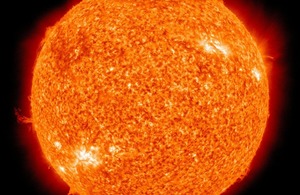Space weather and the National Space Operations Centre (NSpOC)
Information on how the The Met Office delivers space weather services.

In April 2024, the Met Office Space Weather Operations Centre (MOSWOC) celebrated its 10th anniversary of becoming the UK operational centre for delivery of space weather services to government, military, industry and the public.
The Met Office, as a partner organisation to the National Space Operations Centre (NSpOC), will be delivering space weather services that underpin, complement, and enhance NSpOC capabilities. It is one of a small handful of 24/7 space weather prediction centres around the globe. Users of the Monitor Space Hazards digital service will be notified of the space weather alerts issued by MOSWOC.
Space weather is recognised as a significant risk on the UK government National Risk Register and MOSWOC provides vital information to help build the resilience of UK infrastructure and industries to space weather events.
Why is space weather such a threat?
Space weather is a collective term used to describe phenomena largely originating from the Sun that can cause changes to our atmosphere and to environmental conditions in near-Earth space. There are three main types of space weather, outlined below.
Solar flares
Solar flares reach Earth in around 8 minutes and can cause impacts such as high frequency radio blackouts.
Solar energetic particles
These particles travel somewhat slower, arriving at Earth on a timescale of minutes to hours, leading to radiation storms, which can impact on electronic systems and potentially harming astronauts if not protected.
Coronal mass ejections (CMEs)
These take between around 15-96 hours to reach Earth and cause geomagnetic storms, which can impact on many systems in space, the signals they use to communicate with ground-stations and ground-based infrastructure such as power grids.

NASA’s Solar Dynamics Observatory captured this image of a solar flare – as seen in the bright flash in the lower right – on May 9, 2024. The composite image combines three wavelengths of extreme ultraviolet light that highlight the extremely hot material in flares and which is colorized in green, blue, and red. Credit: NASA/SDO
When particles, radiation, and matter, which have been ejected from the Sun, interact with the Earth’s upper atmosphere and surrounding magnetic field they produce a variety of effects.
The most recognisable and visible space weather effects are the auroras (Northern and Southern Lights). However, as well as producing these spectacular natural phenomena, space weather represents a real threat and can have an impact upon national infrastructure, technology, and communications systems.
Space weather conditions constantly vary. The Sun continuously emits streams of charged particles, known as the solar wind, which travel outwards into the Solar System hitting all the planets.
A greater impact to the Earth is felt when the solar wind is stronger or more dense, or when there are solar eruptions, which can occur in the form of flares. When we experience solar storms from large active regions on the Sun, a significant number of eruptive phenomena can be expected over a period of up to two weeks.
The Sun has an 11-year cycle during which solar activity levels fluctuate. We are currently approaching solar maximum – the time during which the Sun is the most active. During this period, there will be more energy being released from the Sun into the Solar System, meaning the Earth may experience more intense affects from space weather. This makes monitoring space weather events crucial in order to mitigate the effects as much as possible.
Working in partnership
Space weather is a global concern and significant space weather events will affect large areas of the globe, across nations and continents.
The Met Office works closely with international partners around the world to develop space weather monitoring and forecasting capability and to share and develop our collective knowledge and information about space weather and its impacts.